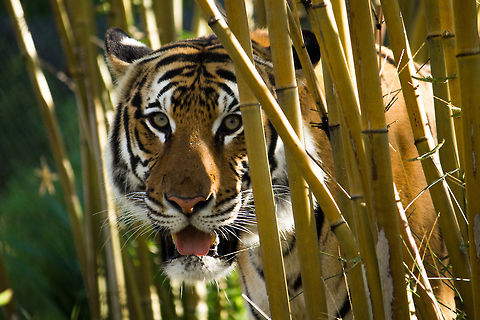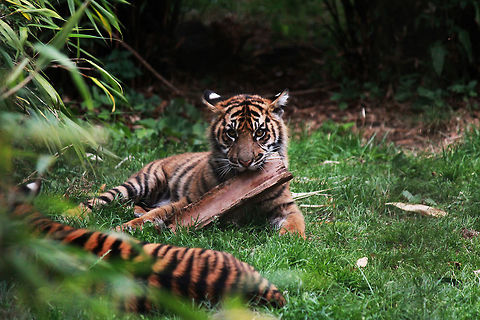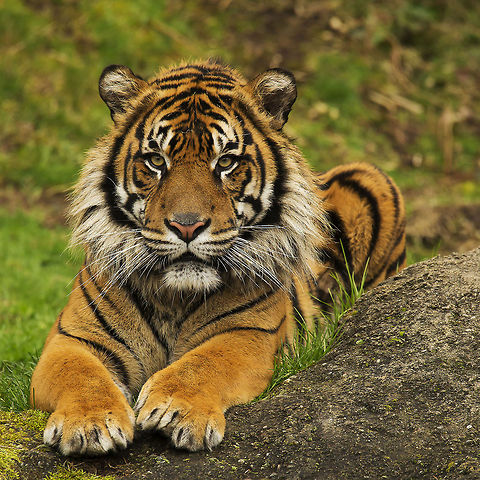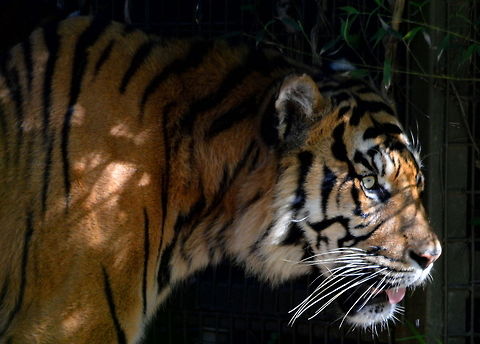
Appearance
The Sumatran tiger has been described as darker in fur colour and as having thicker stripes than the Javan tiger. Stripes tend to disintegrate into spots near their ends, and lines of small dark specks between regular stripes may be found on the back, flanks and hind legs. The frequency of stripes is higher than in other subspecies.The Sumatran tiger is one of the smallest tiger subspecies. Males weigh 100 to 140 kg and measure 220 to 225 cm in length between the pegs with a greatest length of skull of 295 to 335 mm . Females weigh 75 to 110 kg and measure 215 to 230 cm in length between the pegs with a greatest length of skull of 263 to 294 mm .
Males have a bearded and maned appearance; neck and cheek hair are well developed.

Distribution
In 1994, the largest population of Sumatran tigers was reported from the Gunung Leuser National Park as comprising 110 to 180 individuals.Their habitat ranges from lowland forest to sub-mountain and mountain forest including some peat moss forests. According to the Tiger Information Center and the World Wildlife Fund, there are no more than 500 of these tigers left in the wild with some estimates considerably lower.
Sumatra has undergone much agricultural growth, and as a result, tiger habitat has become fragmented with about 400 tigers inhabiting five national parks and two game reserves. The largest populations live in the Kerinci Seblat National Park and Gunung Leuser National Park. Another 100 live in unprotected areas that are in danger of being lost to agriculture as of 2012. The tigers that live in unprotected areas are very vulnerable to poaching as well as the killing of problem animals that come in contact with villagers encroaching upon the animals' habitat.

Status
In 2006, the Indonesia Forestry Service, the Natural Resources and Conservational Agency and the Sumatran Tiger Conservation Program began talks with commercial concession holders and Asia Pulp & Paper, and set the foundations for the Senepis Buluhala Tiger Sanctuary, an area that covered 106,000 hectares in Riau by 2008. These organizations formed The Tiger Conservation Working Group with other interested parties and the project is recognised as a pioneering initiative.In 2007, the Indonesian Forestry Ministry and Safari Park established cooperation with the Australia Zoo for the conservation of Sumatran Tigers and other endangered species. The cooperation agreement was marked by the signing of a Letter of Intent on 'Sumatran Tiger and other Endangered Species Conservation Program and the Establishment of a Sister Zoo Relationship between Taman Safari and Australia Zoo' at the Indonesian Forestry Ministry office on July 31, 2007. The program includes conserving Sumatran Tigers and other endangered species in the wild, efforts to reduce conflicts between tigers and humans, and rehabilitating Sumatran Tigers and reintroducing them to their natural habitat.
A 110,000 acre conservation area and rehabilitation center, Tambling Wildlife Nature Conservation, has been set up on the edge of a national park on the southern tip of Sumatra . On October 26 2011, a tigress who had been captured with an injured leg in early October delivered three male cubs in a temporary cage, while waiting for release after her recovery.

Behavior
Sumatran tigers commonly prey on larger ungulates like wild pig, Malayan Tapir, and deer, and sometimes also smaller animals such as fowl, monkeys, and fish. Orangutans could be prey, but since they spend a minimal amount of time on the ground, tigers rarely catch one.Sumatran tigers will sometimes prey upon mice and other small mammals when larger prey is scarce.

Habitat
In 1994, the largest population of Sumatran tigers was reported from the Gunung Leuser National Park as comprising 110 to 180 individuals.Their habitat ranges from lowland forest to sub-mountain and mountain forest including some peat moss forests. According to the Tiger Information Center and the World Wildlife Fund, there are no more than 500 of these tigers left in the wild with some estimates considerably lower.
Sumatra has undergone much agricultural growth, and as a result, tiger habitat has become fragmented with about 400 tigers inhabiting five national parks and two game reserves. The largest populations live in the Kerinci Seblat National Park and Gunung Leuser National Park. Another 100 live in unprotected areas that are in danger of being lost to agriculture as of 2012. The tigers that live in unprotected areas are very vulnerable to poaching as well as the killing of problem animals that come in contact with villagers encroaching upon the animals' habitat.Sumatran tigers commonly prey on larger ungulates like wild pig, Malayan Tapir, and deer, and sometimes also smaller animals such as fowl, monkeys, and fish. Orangutans could be prey, but since they spend a minimal amount of time on the ground, tigers rarely catch one.
Sumatran tigers will sometimes prey upon mice and other small mammals when larger prey is scarce.

Predators
The Sumatran tiger's habitat is being drastically reduced by logging, clearing for agriculture and plantations, and settlement. In Sumatra, tiger habitat is shrinking fast with timber resources being exploited on a large scale. The tiger in Sumatra faces precarious prospects if its present distribution continues to be substantially reduced and populations become small, fragmented and isolated from one another. They have other problems, such as; illegal logging, poaching and illegal hunting. Although the numbers of tigers incidentally killed or as a result of human-tiger conflict are significant, most tigers in Sumatra are apparently killed deliberately for commercial gain. Moreover, there is no evidence that tiger poaching has declined significantly since the early 1990s. This is despite intensified conservation and protection measures in Sumatra, and the apparent success globally in curtailing markets for tiger bone.
Evolution
Analysis of DNA is consistent with the hypothesis that Sumatran tigers have been isolated from other tiger populations after a rise in sea level that occurred at the Pleistocene to Holocene border . In agreement with this evolutionary history, the Sumatran tiger is genetically isolated from all living mainland tigers, which form a distinct group closely related to each other.References:
Some text fragments are auto parsed from Wikipedia.